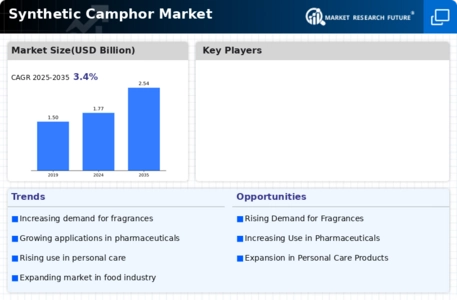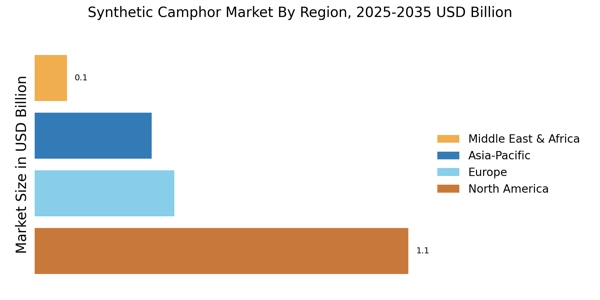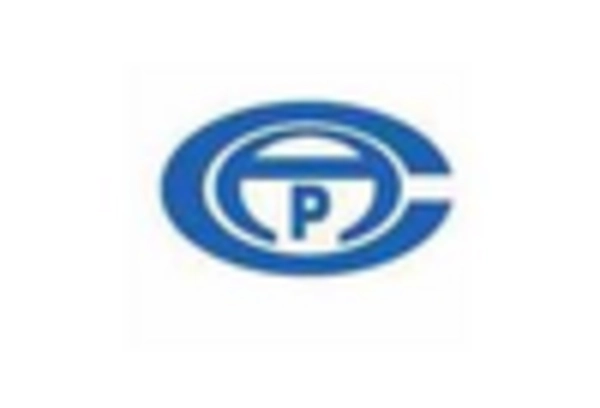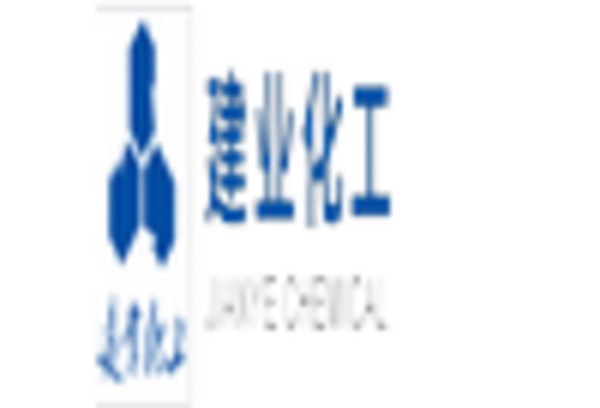Increasing Use in Food Industry
The Synthetic Camphor Market is experiencing a notable increase in demand due to its applications in the food sector. Synthetic camphor is utilized as a flavoring agent and preservative in various food products. The growing consumer preference for natural and safe food additives has led to a rise in the use of synthetic camphor, which is perceived as a safer alternative to certain natural compounds. According to recent data, the food industry is projected to account for a significant share of the synthetic camphor market, with an estimated growth rate of around 5% annually. This trend indicates a shift towards incorporating synthetic camphor in food formulations, thereby enhancing its market presence.
Rising Demand in Personal Care Products
The Synthetic Camphor Market is witnessing a surge in demand driven by its incorporation in personal care products. Synthetic camphor is valued for its aromatic properties and is commonly found in lotions, creams, and ointments. The increasing consumer awareness regarding skincare and personal hygiene is propelling the growth of this segment. Market data suggests that the personal care sector is expected to grow at a compound annual growth rate of approximately 6% over the next few years. This growth is likely to be fueled by the rising trend of self-care and wellness, leading to an increased utilization of synthetic camphor in various formulations.
Technological Advancements in Production
The Synthetic Camphor Market is benefiting from technological advancements in production processes. Innovations in manufacturing techniques have led to more efficient and cost-effective methods of synthesizing camphor. These advancements not only enhance the quality of the product but also reduce production costs, making synthetic camphor more accessible to various industries. As a result, the market is expected to expand, with production capacities likely to increase by 10% in the coming years. This growth in production capabilities is anticipated to meet the rising demand across multiple sectors, including pharmaceuticals and cosmetics.
Regulatory Support for Synthetic Products
The Synthetic Camphor Market is positively influenced by regulatory support for synthetic products. Governments are increasingly recognizing the benefits of synthetic camphor in various applications, leading to favorable regulations that promote its use. This support is particularly evident in the pharmaceutical and cosmetic sectors, where synthetic camphor is often preferred for its consistency and reliability. Recent regulatory frameworks have streamlined the approval processes for synthetic ingredients, potentially increasing market access for synthetic camphor. As a result, the market is expected to see a steady growth trajectory, with an anticipated increase in demand from regulated industries.
Growth in Aromatherapy and Wellness Sectors
The Synthetic Camphor Market is experiencing growth due to the rising popularity of aromatherapy and wellness products. Synthetic camphor is recognized for its therapeutic properties, making it a sought-after ingredient in essential oils and diffusers. The wellness trend, characterized by an increasing focus on mental health and relaxation, is driving consumers towards products that incorporate synthetic camphor. Market analysis indicates that the aromatherapy segment is projected to grow at a rate of 7% annually, reflecting a broader acceptance of synthetic camphor in holistic health practices. This trend is likely to bolster the overall market for synthetic camphor.


















Leave a Comment